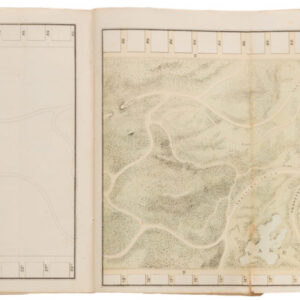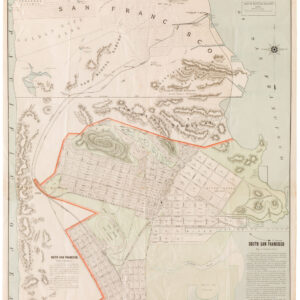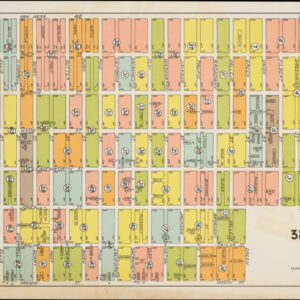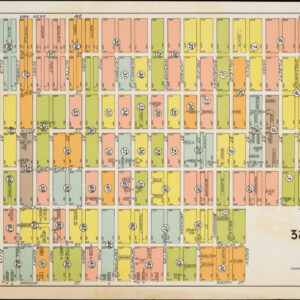A large Britton & Rey cartographic advertisement for Sutro’s shore-lands.
Map of the Ocean Shore Lands. Sutro Baths & Museum Sutro Heights.
$875
In stock
Description
This large advertisement promotes some of the key real estate ventures associated with one of San Francisco’s first property magnates (and mayor), Adolph Sutro. The sheet was not commissioned by Sutro himself, who had died in 1898, but was a solicitation by his heirs as they tried to liquidate Sutro’s land holdings according to his instructions.
The advertisement is essentially a detailed encouragement for people to vote “YES” on all Bond Propositions at a special election held on December 20, 1912. The purpose of this election was to allow the City of San Francisco to purchase the so-called shore-lands, a strip of land at the northwestern tip of the San Francisco Peninsula and separating Lincoln Park from the oceanfront. The area included the famous Sutro Baths and Museum. The sale had been a long time coming and was an express wish made by Sutro himself in his will. Should the city be endowed with the financial capacity to purchase this prime real estate, then the 2121 acres known as Sutro Heights would be donated to the city for recreational use by its inhabitants.
The sheet, which is printed on both sides and therefore meant for distribution rather than mounting, essentially consists of a map showing the land in question, followed by extensive text explaining the legal framework and encouraging the city’s inhabitants to support its acquisition through this ballot. Below the map, we find three early photographs depicting some of Sutro’s most famous San Francisco landmarks (i.e. a view of the shore-lands, the Sutro Baths, and the parapet of Sutro Heights). The map clearly delineates the area that is under consideration, marking the land for sale in a slightly darker green than the Sutro Heights plot, which would be donated to the city following a purchase.
In sum, this sheet captures some of the important development dynamics of San Francisco in the early 20th century. This was a city still reeling from the devastation of the earthquake six years earlier but well on the path to becoming one of the most iconic and liveable cities in the United States.
Context is Everything
Adolph Sutro’s real estate ventures in San Francisco left an indelible mark on the city’s landscape and history. Born in Prussia in 1830, Sutro arrived in San Francisco during the mid-19th century Gold Rush. His business endeavors were characterized by a pragmatic and innovative approach, and their success contributed to the city’s rapid development in the late 19th century.
Sutro is perhaps best known for his most monumental project – the Sutro Baths. Completed in 1896, the baths stood as an engineering marvel, boasting a massive glass-roofed structure containing a saltwater swimming pool and various attractions. The baths were a testimony to Sutro’s creative vision but also had a purely practical dimension in that they provided San Franciscans with an entertaining and healthy respite from the chilly waters of the Pacific.
Beyond the Sutro Baths, Sutro’s legacy in real estate included the development of the Sutro Heights Park. Acquiring a significant parcel of land overlooking the Pacific Ocean, he transformed the area into a lush public park. Sutro’s intention was to provide an accessible and scenic space for the city’s residents, allowing them to escape the hustle and bustle of the urban core. Yet Sutro’s impact was not confined to recreational spaces. He was also instrumental in promoting the expansion of the city’s transportation infrastructure. This included the creation of the Sutro Railroad, aimed at connecting downtown San Francisco to the scenic wonders of Lands End. While financial constraints prevented such a railroad from being realized, the vision reflected Sutro’s commitment to enhancing the city that he loved and called home.
Adolph Sutro’s initiatives are crucial to San Francisco’s history. By creating spaces like the Sutro Baths and Sutro Heights Park, he contributed to the well-being of the community and provided its inhabitants with an opportunity to enjoy the natural beauty that surrounds the city. His innovative thinking and bold undertakings established him as a pioneer in urban development and set a powerful precedent for entrepreneurs and city planners in the early 20th century.
Adolph Sutro’s real estate ventures in San Francisco left an enduring legacy. He exerted an influence on San Francisco’s evolution that cannot be overstated, solidifying his place as one of the most significant figures in the city’s history.
Census
Being an advertisement for a specific event, very few of these sheets have survived until today. The OCLC notes only two institutional copies (no. 925375401) at Yale and the California Historical Society, respectively. On the open market, we have not been able to identify any examples – historical or current – of intact sheets of this kind, making this an extremely rare find.
Cartographer(s):
Britton & Rey (1852 – 1906) was a lithographic printing firm based in San Francisco and founded by Joseph Britton and Jacques Joseph Rey in 1852. Especially during the second half of the 19th century, Britton and Rey became the leading lithography firm in San Francisco, and probably California. Among their many publications were birds-eye-views of Californian cities, depictions of the exquisite landscapes, stock certificates, and no least maps. While Rey was the primary artist, Britton worked not only as the main lithographer but was essentially also the man running the business. In addition to their own material, the firm reproduced the works of other American artists like Thomas Almond Ayres (1816 – 1858), George Holbrook Baker (1824 – 1906), Charles Christian Nahl (1818 – 1878), and Frederick August Wenderoth (1819 – 1884). Following Rey’s death in 1892 Britton passed the form on to Rey’s son, Valentine J. A. Rey, who ran it until the great earthquake and fire of 1906 destroyed most of the company’s assets.
Joseph Britton (1825 – July 18, 1901) was a lithographer and the co-founder of the prominent San Francisco lithography studio Britton and Rey. He was also a civic leader in San Francisco, serving on the Board of Supervisors and helping to draft a new city charter. In 1852, he became active in lithography and publishing, first under the name ‘Pollard and Britton,’ and then ‘Britton and Rey,’ a printing company founded with his friend and eventual brother-in-law Jacques Joseph Rey. Britton and Rey became the premier lithographic and engraving studio of the Gold Rush era, producing letter sheets, maps, and artistic prints.
Jacques Joseph Rey (1820 – 1892) was a French engraver and lithographer born in the Alsatian town of Bouxwiller. At the age of about 30, he emigrated to America, eventually settling in California. Here, he soon entered into a partnership with local entrepreneur and civic leader Joseph Britton. Three years later, Rey also married Britton’s sister, allowing his business partner and brother-in-law Britton to live in their house with them. Rey and Britton were not only an important part of the San Francisco printing and publishing scene but also owned a plumbing and gas-fitting firm. In the early years, both men would sometimes partner up with others on specific projects, but by the late 1860s, their partnership was more or less exclusive.
Condition Description
Splits at folds and some discoloration.
References



![[1906 EARTHQUAKE PANORAMA – FINANCIAL DISTRICT]](https://neatlinemaps.com/wp-content/uploads/2020/10/Screen-Shot-2023-02-06-at-6.55.56-PM-300x300.png)


